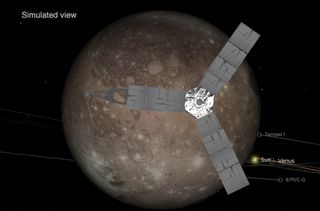Hello, Ganymede! NASA's Juno makes closest visit to Jupiter's largest moon since 2000.
Scientists are hoping for five photos, plus plenty of precious data.

A NASA spacecraft made the closest flyby of Jupiter's largest moon in 21 years on Monday (June 7).
Juno whizzed by the icy moon of Ganymede safely at an altitude of just 645 miles (1,000 kilometers) at 12:56 p.m. EDT (1656 GMT). But we won't get any images or other information for a while, as NASA typically tasks downloads to Earth when the spacecraft is less busy gathering data.
"It's our first close Ganymede flyby in 20 years! Stay tuned for images and science results," the NASA Solar System Twitter account said at the time of flyby. The last such pass of Ganymede was in 2000 by the spacecraft Galileo, which orbited Jupiter and flew by many of its moons between 1995 and 2003.
Related: Photos of Ganymede, Jupiter's largest moon
Juno's next trick will be speeding once more over the cloud tops of Jupiter, on its 34th such pass in the intense radiation environment, on Tuesday (June 8), the agency added. Juno is on a long-term mission to learn more about the planet's interior and weather and was approved for another mission extension, this time to 2025, earlier this year based on its science return since arriving at the Jupiter system in 2016.
The newly accomplished Ganymede flyby could offer crucial information for future exploration of Jupiter's icy moons, where two missions are set to explore in the 2030s: the JUICE mission by the European Space Agency and the Europa Clipper mission by NASA. Icy moons are considered to be promising environments for habitability due to their watery environments and source of energy from the gravitational tug of nearby planets.
The flyby included probing by several of Juno's instruments and cameras: three different cameras, radio instruments, the Ultraviolet Spectrograph (UVS), the Jovian Infrared Auroral Mapper (JIRAM) instruments and the Microwave Radiometer (MWR).
Get the Space.com Newsletter
Breaking space news, the latest updates on rocket launches, skywatching events and more!
The last instrument was attempting to identify the ingredients of the lighter and darker patches of Ganymede's ice shell, NASA said. Only five images from the spacecraft's star camera, JunoCam, are expected to flow back to Earth, however, because the moon appeared and disappeared from the spacecraft's view in just 25 minutes during the flyby.
"Juno carries a suite of sensitive instruments capable of seeing Ganymede in ways never before possible," principal investigator Scott Bolton, a space scientist at the Southwest Research Institute in San Antonio, said in a NASA statement. "By flying so close, we will bring the exploration of Ganymede into the 21st century."
Ganymede will be the main target of the JUICE mission, which will also explore Callisto and Europa. Before Juno, only three other spacecraft have seen Ganymede, the solar system's largest moon up close. NASA's twin Voyager spacecraft flew by the moon in 1979, and Galileo made the aforementioned close pass of Ganymede in 2000. The moon is larger than the tiny planet Mercury and is the only known moon that has a magnetic field.
Follow Elizabeth Howell on Twitter @howellspace. Follow us on Twitter @Spacedotcom and on Facebook.
Join our Space Forums to keep talking space on the latest missions, night sky and more! And if you have a news tip, correction or comment, let us know at: community@space.com.

Elizabeth Howell (she/her), Ph.D., is a staff writer in the spaceflight channel since 2022 covering diversity, education and gaming as well. She was contributing writer for Space.com for 10 years before joining full-time. Elizabeth's reporting includes multiple exclusives with the White House and Office of the Vice-President of the United States, an exclusive conversation with aspiring space tourist (and NSYNC bassist) Lance Bass, speaking several times with the International Space Station, witnessing five human spaceflight launches on two continents, flying parabolic, working inside a spacesuit, and participating in a simulated Mars mission. Her latest book, "Why Am I Taller?", is co-written with astronaut Dave Williams. Elizabeth holds a Ph.D. and M.Sc. in Space Studies from the University of North Dakota, a Bachelor of Journalism from Canada's Carleton University and a Bachelor of History from Canada's Athabasca University. Elizabeth is also a post-secondary instructor in communications and science at several institutions since 2015; her experience includes developing and teaching an astronomy course at Canada's Algonquin College (with Indigenous content as well) to more than 1,000 students since 2020. Elizabeth first got interested in space after watching the movie Apollo 13 in 1996, and still wants to be an astronaut someday. Mastodon: https://qoto.org/@howellspace
